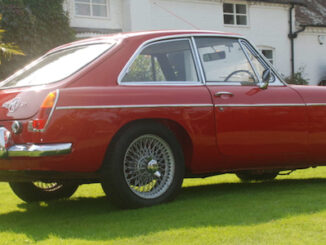Note: This week we are very pleased to have a piece from John Twist of University Motors on the dangers of ethanol, or alcohol, in modern gasoline. Those of us who drive classic British cars, especially ones with original fuel system components, need to be aware of what modern fluids can do to our rides. We appreciate John letting us reprint this article from his most recent newsletter.

“Nearly all of the gasoline sold in the United States contains 10 percent ethanol, which can safely be used in all of today’s gasoline-burning cars and trucks.” (From http://www.ucsusa.org) The operative word is “today’s.” Ethanol is a cleaner burning fuel than gasoline. It is created from biomass, especially corn. Arguments rage about the true environmental impact of growing corn to create ethanol versus drawing crude oil from wells and then refining it. But for now, ethanol is here to stay. Modern cars are designed to use this newer fuel, our MGs are not.
This ethanol enhanced gasoline can wreak havoc with our MG fuel systems. Just last week I had a new SU carburetter float fail I suspect it was the gasohol. This E10 causes our fuel systems to corrode; SU and Stromberg brass metering needles turn green when lying unused. Some have complained that earlier gasoline tank sealers have lifted off in sheets, clogging the fuel pickup at the bottom of the tank (therefore starving the engine for fuel). This E10 gasohol boils at a very low temperature. We hear from MG owners much more now about hot hard restarts. In some southern climates, running an MGC is all but impossible without great modification. And, MG mpg (miles per gallon) suffers a bit as alcohol doesn’t carry the same energy per volume as gasoline.
 A gallon of gasoline has about 33 KwH (Kilowatt Hour) of energy (about 113,000 BTUs) while a gallon of ethanol has about 22 KwH of energy (about 76,000 BTUs). Somehow, that E10 gasoline yields about 112,000 BTUs. Midgrade (89 octane) E10 gasohol costs just over $2.00 per gallon in Grand Rapids today. That works out to about 52,000 BTUs or about 15 KwH per dollar. Consumers Energy sells a KwH from 9¢ to 22¢ depending on the time of day (Remember those smart meters they fitted to your house? Electricity from noon to four, especially in the summer is sold at that higher rate.). So Consumers sells electricity from about 4.5 to11 KwH per dollar. But that’s not the whole picture. Our internal combustion engines can deliver ONLY 1/3rd of that energy to the flywheel, and that’s in a “perfect” engine. Another third is sent down the exhaust, and the remaining third is sent into the radiator. If we use a figure of 1/4th efficiency then that gasoline is only delivering about three KwH per dollar. But that’s not what I came to warn about.
A gallon of gasoline has about 33 KwH (Kilowatt Hour) of energy (about 113,000 BTUs) while a gallon of ethanol has about 22 KwH of energy (about 76,000 BTUs). Somehow, that E10 gasoline yields about 112,000 BTUs. Midgrade (89 octane) E10 gasohol costs just over $2.00 per gallon in Grand Rapids today. That works out to about 52,000 BTUs or about 15 KwH per dollar. Consumers Energy sells a KwH from 9¢ to 22¢ depending on the time of day (Remember those smart meters they fitted to your house? Electricity from noon to four, especially in the summer is sold at that higher rate.). So Consumers sells electricity from about 4.5 to11 KwH per dollar. But that’s not the whole picture. Our internal combustion engines can deliver ONLY 1/3rd of that energy to the flywheel, and that’s in a “perfect” engine. Another third is sent down the exhaust, and the remaining third is sent into the radiator. If we use a figure of 1/4th efficiency then that gasoline is only delivering about three KwH per dollar. But that’s not what I came to warn about.
Use fuel stabilizers. Mike and Forrest, here at UML are fans of Startron additive, available at NAPA and other auto supply stores. It claims to negate the bad effects of the alcohol in the gasoline. Mike swears by it. (Mike note: I run it in my chainsaw, weed whipper, generator, snowmobile, diesel pickup truck, toothbrush.) But there is another option!
There are hundreds of stations offering ethanol-free gasoline across the USA and Canada. Find them at www.pure-gas.org. [Note: Pure-Gas also has apps for iOS and Android to help you find ethanol free gas on the road.]
Just today, Geoff McCoach, a continuous customer from the early ’80’s called to remind me of a Sunoco station in Grand Rapids. Residents of Grand Rapids are fortunate to have non-ethanol gasoline available at the Sunoco station, 7061 South Division, just south of 68th Street. It is also available at Alpine Mobil, 1760 Alpine NW and at the BP station, 305 Lake Michigan Drive NW.






I found my local airport is willing to fill up my 5 gallon plastic can with 100 LL (even aviation fuel has reduced lead!). The standard excuse is ‘people need it for their ‘homebuilt’ aircraft’. But in reality, most hobby community airports don’t even ask. The attendant says he always asks out of curiosity and the vast majority of users have classic motorcycles. I find 5 gallons gets me around for most local drives, and I supplement it with Sunoco 100 as needed for longer drives. Yes, in 2016’s $2 gas days it is going for $4+ dollars, but for occasional use it’s not a wallet breaker. And for winter storage I run the tank close to empty of any ‘mix’ and then refill with 5 gallons of aviation. It’s got a greenish tint, a little lead (engine purrs!), and zero alcohol, plus quite a bit of fuel blender-installed stabilizer, as aircraft tend to sit on runways for long periods with fuel in the lines, so it seems like a good solution for me. Yes, of course I don’t have a cat converter. TR4A Owner
Good idea. I for some reason had never thought about hitting up the small local airport.
Thanks for giving John a forum on which to make his brainy critique known. We in the British Car Industry wonder why some companies make all their gasoline with ethanol. The cars which need higher octane are the ones that are most harmed by ethanol, yet the major companies put ethanol in their 93-octane pumps. No modern car needs 93-octane, so why!!?
Seems the gasoline companies and the car companies don’t talk at all. I am just happy I can still find ethanol free gas – anywhere!
And agree with you on John Twist. A pleasure to be able to “print” his wisdom.
Ethanol in gasoline is not the oil companie’s idea. It is a federal mandate. 100 LL AV gas has more lead than auto fuel did but is less than it used to have. It is very stabile. High compression aircraft engines are looking for alternate fuels as the lead will be phased out. There are a few companies with promising fuels in testing now.